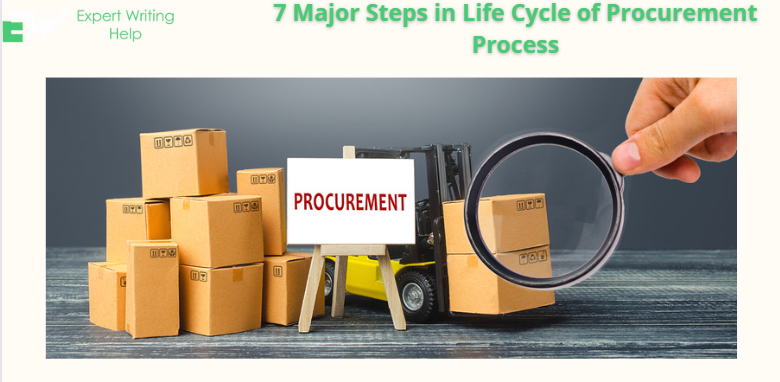LIFE CYCLE OF PROCUREMENT PROCESS

LIFE CYCLE OF PROCUREMENT PROCESS
Procurement is a universal concept that is right in the middle of any organization. When thinking of the day-to-day running of an organization, you will realize that in every task, on top of having the right human resource, you will also need materials to facilitate the production of performance. Acquisition of these materials lies squarely in the procurement department. So what is procurement and more importantly which is the life cycle of the procurement process.
Procurement is defined as the act of obtaining goods and services required in the propagation of business. However, it goes deeper and is further defined as the process of obtaining goods and services externally and is often a competitive process that involves bidding in an attempt to get the best, high-quality goods and services at the best prices (the lowest price) promptly. The life cycle of procurement process is only complete after the proper recording of receipts and documentation for future referencing and auditing. Without any more delay let me walk you through the life cycle of the procurement process.
7 Major Steps in Life Cycle of Procurement Process
Are you a CIPS student or qualified procurement professional? then you know procurement is a series of event that make up procuring of goods. These key seven steps of procurement life cycle offers a blueprint for your procurement management to run efficiently and effectively.
Identify the business needs
A procurement officer, anticipation and identification of business needs lies squarely in your domain. However, we do not expect you to do this all by yourself, after all, there is only so much you can do. The procurement department depends on other departments such as human resource department, store department, production department and accounts department for information. The very first bit of the whole process depends on the ability to identify a need and the rest is just a way to correct it.
Create a list of suppliers
CIPS level 4 assignment emphasis procurement professionals should build strong supplier relationship management. In this stage the procurement team compiles a list of potential suppliers offering the needed goods or services. During this phase, the team needs to incorporate strategic procurement practices in order to get the best possible list of suppliers to choose from.
Inclusion in the supply list should involve rigorous vetting process. The procurement team should conduct market research and gather as much information to make an informed decision. Get to learn prices, reputation, production capacity, communication and quality of goods or services.
Upon successful completion of this phase you will have created a list of vendors who offer what you are looking for, and narrow it down to a few based on certain criteria.
Select a supplier and negotiate terms of engagement
Now with a list of the most probable suppliers, get in touch with them and engage them to get as many details of the product/service offered, prices, discounts, after-sale services, warranties, transport services, return policy and any other relevant details.
Well for a business with going concern, you can be certain that it will not be the last time you will need the commodity you are shopping for and it will work to your advantage if you build a good rapport while you are at it. After all, it doesn’t hurt to be in their good books.
Good rapport goes further than just having contacts for another day but it helps you out when you decide to ask for the goods on credit… I have a feeling you are getting the hang of this…
Now, that you know what you want and have an idea of your budget, work around these and try and get the best deal you can and save your firm some cash while you are at it while not compromising the quality. This calls for you to bargain and bring you’re A-game. At the end of the day, you will have a vendor that you feel is the best fit for your organization and this brings us to the question, WHAT NEXT?
Create and send purchase order
Well, the next thing is to get the ball rolling and ‘make things official’, pun intended. According to the terms you had agreed on, you should now create a purchase order clearly citing the quantity needed, quality, size and any other specifications of the goods you intend to purchase. It is very important that you get these details correctly to avoid returning the goods and this would be quite an inconvenience. Well, before making this order, you need to go back to the drawing board and get a grasp on the optimum order level that will work for you considering the discounts and ordering cost.
Invoice and order
Once the purchase order is received by the vendor, you should hear from them as they reply and give you an invoice for the goods you had requested in the purchase order. This invoice is a way for you to countercheck whatever they intend to deliver and countercheck it with your purchase order. If they both lineup, you can confirm as you await delivery of your order.
The invoice does more than just give details of the order but also provides payment details. These could range anywhere from cash on delivery to credit terms. At this point, before confirming that their invoice is correct, also countercheck that you get all that you had negotiated for in terms of discounts. You might learn of an extra discount in the terms of payment. Extra tip, vendors tend to give a discount on cash on delivery to motivate cash payment and improve their cash flow. Thank me later.
Pay for goods and verify delivery
The arrival of goods signifies the beginning of the end of the procurement process. Verify you have received the ordered goods. This means that you need to countercheck the delivery note against the goods as well as against the purchase order. The window of returning goods if not delivered as agreed is still open and you can get the vendor to exchange them for you. After all, you need to get what you pay for.
Once you confirm that you have all that you ordered, it is only fair that you honor your payment agreement.
Update your record
After all, is said and done, accountability should be maintained at all times. This means that you
need to keep proper paperwork of your engagement with the vendors. This will come in handy when it’s time to reconcile your books. After all the good work has been done it would be a shame to be put under scrutiny on allegations of fraud.
And that cuts it for the procurement process. It is basically the flow of events from the identification of business needs right to the point where you keep your record. I am sure that you now have a clear picture of what procurement is all about.





